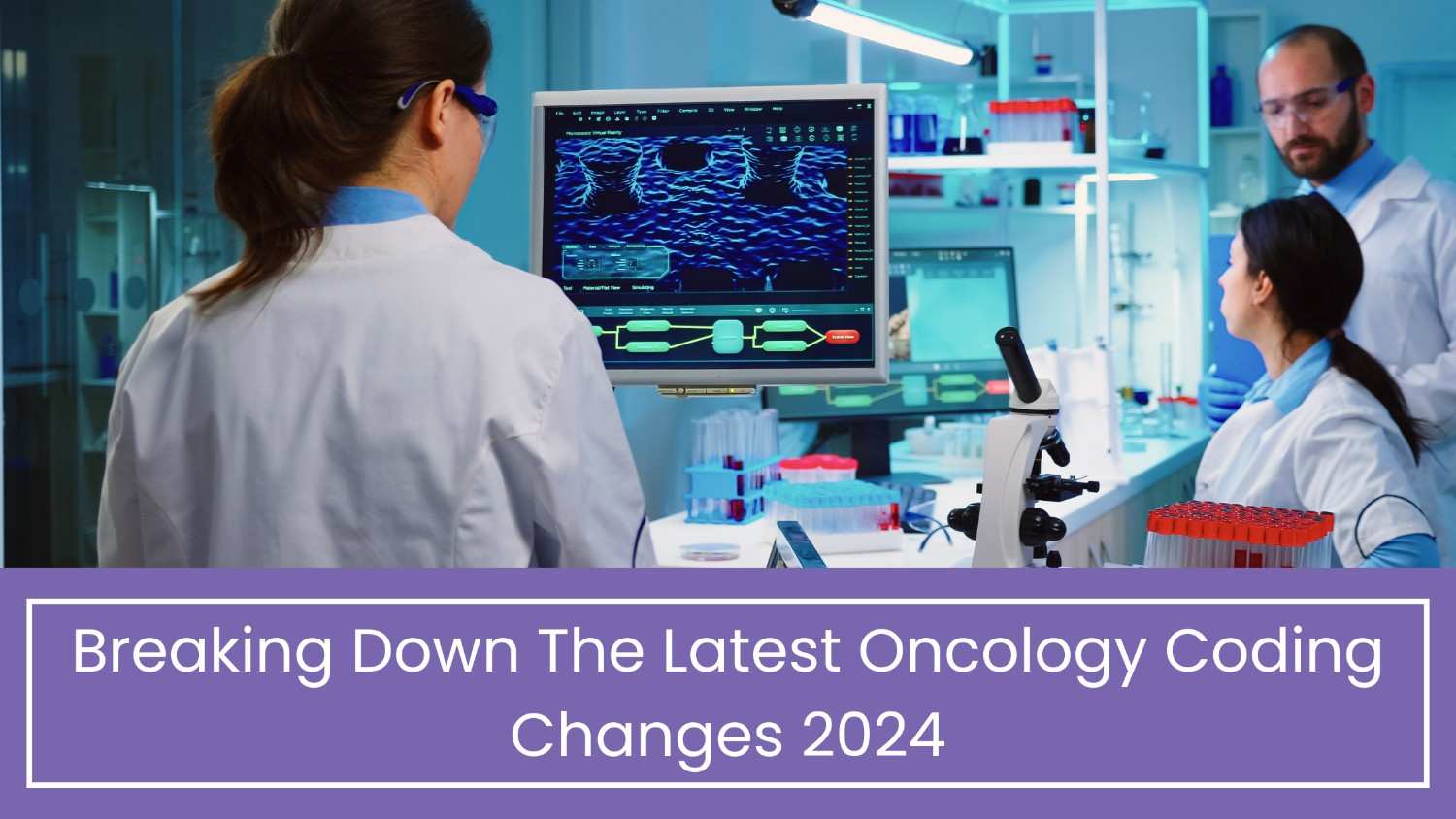Breaking Down The Latest Oncology Coding Changes 2024
The 2024 annual update to the Current Procedural Terminology (CPT) represents a substantial shift in medical coding landscapes, unveiling 230 fresh codes, revising 70 existing ones, and eliminating 49 others. This expansive overhaul mirrors the continuous evolution of medical procedures, technologies, and treatments, demanding a corresponding adjustment in coding methodologies to accurately document and bill for these advancements.
The ICD-10-CM update introduces 395 novel diagnosis codes, with a notable emphasis on refining descriptors to better capture accidents and injuries. Although the direct impact on radiology practices may appear limited, it remains imperative for practitioners to fully grasp these modifications and tailor their practice systems accordingly. A thorough understanding of these updates ensures adherence to regulatory standards, maximizes reimbursement potential, and optimizes workflow efficiency within radiology practices.
Table of Contents
Unveiling Breakthroughs in Diagnostic Radiology
Coronary Fractional Flow Reserve (FFR) with CT:
The landscape of diagnostic radiology experiences a transformative shift with the introduction of Category I code 75580. This ground breaking addition supersedes Category III codes 0501T, 0502T, 0503T, and 0504T, delineating a cutting-edge approach to non invasive coronary FFR estimation. Harnessing the power of augmentative AI software analysis, this code facilitates the derivation of estimated coronary FFR from data acquired through coronary CT angiography (CCTA).
However, it’s imperative to emphasize that the involvement of a qualified healthcare professional for interpreting and reporting the analysis is indispensable for accurate diagnosis. Moreover, when this interpretation coincides with CCTA on the same day, the seamless integration of 75580 with CCTA coding (75574) optimizes diagnostic precision and procedural efficiency.
Cardiac Intraoperative Ultrasound (IOUS) Services:
Embracing the forefront of technological innovation, the latest coding revisions encompass a comprehensive suite of codes tailored to capture the intricacies of cardiac IOUS procedures. These codes include:
- CPT Code 76984: Ultrasound, intraoperative thoracic aorta (e.g., epiaortic), diagnostic
- CPT Code 76987: Intraoperative epicardial cardiac ultrasound for congenital heart disease, encompassing placement, manipulation of transducer, image acquisition, interpretation, and report
- CPT Code 76988: Encompassing placement, manipulation of transducer, and image acquisition only
- CPT Code 76989: Focused solely on interpretation and report
The significance of cardiac IOUS extends far beyond its technical prowess, as it emerges as an indispensable tool in cardiothoracic surgeries. Providing invaluable insights into cardiac structures, IOUS guides real-time surgical decision-making, enhancing operative precision and patient outcomes. Its ability to offer intraoperative guidance and critical perioperative information underscores its pivotal role in shaping operative strategies, ensuring optimal patient care and surgical success.
Revolutionizing Vascular Ultrasound Guidance Reimbursement:
Commencing January 1, 2024, a pivotal shift in Medicare reimbursement policies is poised to reshape the landscape of vascular ultrasound guidance procedures. Notably, CPT code 76937, which traditionally denoted “Ultrasound guidance for vascular access requiring ultrasound evaluation of potential access sites,” will undergo a significant alteration. Henceforth, this code will no longer be reimbursed separately for procedures encompassing radiological supervision and interpretation.
The amalgamation of ultrasound guidance into primary procedures represents a fundamental overhaul in billing practices, necessitating a revaluation of reimbursement strategies across healthcare sectors. With the exclusion of separate billing for ultrasound guidance, healthcare providers face potential financial ramifications, with an estimated loss of $37.66 per procedure under global billing, or $13.43 for the professional component, based on national Medicare reimbursement rates.
In response to this regulatory adjustment, various specialty societies have vehemently expressed their dissent, lodging formal objections with CMS. While uncertainties loom large, the medical community remains cautiously optimistic, harboring hopes that concerted advocacy endeavors may yet reverse this decision and safeguard equitable reimbursement practices for vascular ultrasound guidance procedures.
Advancing Interventional Radiology Procedures:
Against the backdrop of regulatory transformations, interventional radiology witnesses notable strides, particularly in the domain of Dorsal Sacroiliac Joint Arthrodesis. The introduction of Category I code 27278 represents a significant leap forward, supplanting the existing Category III code 0775T. Insights gleaned from the American College of Radiology elucidate that this novel code facilitates the reporting of percutaneous intra-articular placement of fusion implant(s) directly into the sacroiliac (SI) joint, guided by imaging, typically from a posterior/dorsal approach.
Simultaneously, revisions to incumbent code 27279 broaden its purview, encompassing percutaneous placement of transfixation devices, such as screws, across the SI joint for fusion, typically from a lateral approach. These nuanced modifications herald a new era of precision and clarity in documenting arthrodesis procedures, enhancing documentation accuracy and ensuring procedural reimbursement alignment with clinical practices.
Innovative Procedure Codes and Descriptions:
27278 – Arthrodesis, sacroiliac joint, percutaneous, with image guidance, including placement of intra-articular implant(s), without placement of transfixation device.
27279 – Arthrodesis, sacroiliac joint, percutaneous or minimally invasive (indirect visualization), with image guidance, includes obtaining bone graft when performed, with placement of transfixation device.
Equipped with detailed descriptions and streamlined categorizations, these revised codes empower healthcare providers with enhanced clarity and specificity in documenting sacroiliac joint arthrodesis procedures. Such precision facilitates accurate reporting, ensuring optimal reimbursement and promoting the delivery of high-quality patient care within interventional radiology settings.
Exploring Cutting-Edge Radiological Procedures
Transcervical Radiofrequency Ablation (RFA) of Uterine Fibroids:
Embarking on a new era in uterine fibroid treatment, the unveiling of Category I code 58580 signifies a transformative leap forward, effectively superseding the previous Category III code 0404T. This innovative code encapsulates the intricacies of transcervical radiofrequency ablation procedures for uterine fibroids, offering a comprehensive framework inclusive of intraoperative ultrasound guidance and monitoring. With meticulous attention to detail, this code not only streamlines documentation processes but also ensures thorough reporting of this advanced treatment modality, promising enhanced patient care and procedural accuracy.
Coronary Intravascular Lithotripsy (IVL) Interventions:
In the realm of coronary interventions, the introduction of Category I code 92972 heralds a pivotal advancement, replacing the former Category III code 0715T. Designed to address heavily calcified coronary arteries, this add-on code seamlessly integrates with primary procedure codes for coronary transluminal angioplasty, atherectomy, or stent placement. By delineating the nuances of coronary IVL procedures, this code expansion facilitates precise documentation and billing practices within interventional cardiology settings, ultimately enhancing procedural efficacy and patient outcomes.
Cystourethroscopy Advancements:
Embracing innovation in urological interventions, the inclusion of CPT code 52284 marks a significant milestone in cystourethroscopy procedures. This newly introduced code defines procedures involving mechanical urethral dilation and urethral therapeutic drug delivery, utilizing a drug-coated balloon catheter to address urethral stricture or stenosis in male patients. With the incorporation of fluoroscopy guidance where applicable, this code expansion underscores the relentless pursuit of procedural excellence and patient-centric care in urological practice, promising improved treatment outcomes and patient satisfaction.
Navigating Emerging Technologies with Category III Codes
Category III codes serve as conduits for emerging technologies and innovative procedures, providing a platform for data collection and analysis before potential mainstream adoption. The landscape of medical innovation is illuminated by the introduction of several new Category III codes for 2024. Noteworthy additions encompass codes for quantitative MRI analysis of the brain, percutaneous injection of calcium-based biodegradable osteoconductive material, ultrasound-based radiofrequency echographic multi-spectrometry for bone-density assessment, and opto-acoustic imaging of the breast. These codes not only shed light on cutting-edge technologies but also pave the way for future advancements in patient care and diagnostic accuracy.
Unraveling ICD-10-CM Code Changes
In the realm of diagnosis coding, the latest ICD-10-CM updates bring forth expanded coding options for breast density assessment, aligning with the Breast Imaging Reporting and Data System (BI-RADS) standards. The introduction of specific codes for different degrees of breast density and laterality offers enhanced granularity in imaging reporting, facilitating comprehensive patient assessment and tailored treatment planning. By providing a standardized framework for breast density documentation, these revisions empower healthcare providers to deliver personalized care and ensure optimal patient outcomes in breast health management.
Concluding
As we journey through the landscape of radiological advancements and procedural innovations, it becomes evident that the field of medical imaging is undergoing a transformative evolution. With each new code and procedure, healthcare professionals are equipped with enhanced tools and methodologies to deliver precise diagnoses and personalized care to patients. By staying informed, adapting to changes, and embracing innovation, we pave the way for a brighter future in radiology and medical imaging.
Choose Practolytics as your trusted medical billing partner to streamline your revenue cycle management. With our cutting-edge technology and experienced team, we ensure accurate billing, timely reimbursements, and compliance with regulatory standards, allowing you to focus on delivering exceptional patient care. Partner with Practolytics today and experience the difference in your medical billing process.
ALSO READ –Top 7 Ways to Improve Medical Coding for Your Practice
Talk to Medical Billing Expert Today — Get a Free Demo Now!






